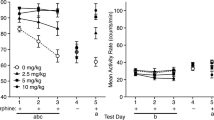Abstract
The motivational effect of naloxone administration in the non-dependent laboratory mouse was examined with taste and place conditioning procedures. Thus, male CD1 mice without any history of drug exposure avoided a cue paired with three SC injections of as little as 0.1 mg/kg naloxone HCl. The aversive effect of naloxone was also seen in DBA/2 and C57BL/6 mice. In addition, it only occurred with the minus isomer and not the plus isomer, and it was potentiated by implantation, 3 days prior to training, of a morphine-containing (37.5 mg) but not a placebo pellet. Naloxone injection, therefore, acts as an aversive stimulus in naive mice and this is probably produced by decreases in activity of endogenous opioid peptide systems. Together with other data, the present results support the conclusion that the aversive effect of opioid receptor blockade in the opiate non-dependent organism may be general to a wide range of species including primates. The importance of training and testing variables for observing the naloxone aversive effect is discussed. Advantages of studying preference conditioning with mice are also given.
Similar content being viewed by others
References
Booth DA, Davis JD (1973) Gastrointestinal factors in the acquisition of oral sensory control of satiation. Physiol Behav 11:23–29
Downs DA, Woods JA (1976) Naloxone as a negative reinforcer in rhesus monkeys: effect of dose, schedule, and narcotic regimen. Pharmacol Rev 27:397–436
El-Sobky A, Dostrovsky JO, Wall PD (1976) Lack of effect of naloxone on pain perception in humans. Nature 263:783–784
Grevert P, Goldstein A (1977) Effects of naloxone on experimentally induced ischemic pain and on mood in human subjects. Proc Natl Acad Sci USA 74:1291–1294
Grevert P, Goldstein A (1978) Endorphins: naloxone fails to alter experimental pain or mood in humans. Science 199:1093–1095
Hoffmeister F (1986) Negative reinforcing properties of naloxone in the non-dependent rhesus monkey: influence on reinforcing properties of codeine, tilidine, buprenorphine, and pentazocine. Psychopharmacology 90:441–450
Hoffmeister F, Wuttke W (1973) Negative reinforcing properties of morphine-antagonists in naive rhesus monkeys. Psychopharmacology 33:247–258
Horowitz GP (1981) Pharmacogenetic models and behavioral responses to opiates. NIAAA Research Monograph 6:209–232
Janowsky DS, Judd LL, Huey L, Segal D (1979) Effects of naloxone in normal, manic, and schizophrenic patients: evidence for alleviation of manic symptoms. In: Usdin E, Bunney WE Jr, Kline NS (eds) Endorphins in mental health research. Oxford, New York, pp 435–441
Kirk RE (1968) Experimental design: procedures for the behavioral sciences. Wadsworth, Belmont, CA
Kosterlitz HW, Watt AJ (1968) Kinetic parameters of narcotic agonists and antagonists with particular reference to N-allylnoroxymorphine (naloxone). Br J Pharmacol 33:266–276
Lett BT (1985) The painlike effect of gallamine and naloxone differs from sickness induced by lithium chloride. Behav Neurosci 99:145–150
Mucha RF, Iversen SD (1984) Reinforcing properties of morphine and naloxone revealed by conditioned place preferences: a procedural examination. Psychopharmacology 82:241–247
Mucha RF, Herz A (1985) Motivational properties of kappa and mu opioid agonists studied with place and place preference conditioning. Psychopharmacology 86:274–280
Mucha RF, van der Kooy D, O'Shaughnessy M, Bucenieks P (1982) Drug reinforcement studied by the use of place conditioning in rat. Brain Res 243:91–105
Mucha RF, Millan MJ, Herz A (1985) Aversive properties of naloxone in non-dependent (naive) rats may involve blockade of central beta-endorphin. Psychopharmacology 86:281–285
Pilcher CWT, Stolerman IP (1976) Conditioned flavor aversions for assessing precipitated withdrawal morphine abstinence in rats. Pharmacol Biochem Behav 4:159–163
Robbins RJ (1977) An accurate, inexpensive, calibrated drinking tube. Lab Anim Sci 27:1038–1039
Rodgers RJ, Randall JI (1985) Social conflict analgesia: studies on naloxone antagonism and morphine cross-tolerance in male DBA/2 mice. Pharmacol Biochem Behav 23:883–887
Rodgers RJ, Richards C, Precious JI (1984) Naloxone administration following brief exposure to novelty reduces activity and rearing in mice upon 24 h retest: a conditioned aversion? Psychopharmacology 82:322–326
Sawynok JC, Pinsky C, LaBella FS (1979) On specificity of naloxone as an opiate antagonist. Life Sci 25:1621–1632
Siegel S (1956) Nonparametric statistics for the behavioral sciences. McGraw Hill, New York
Spyraki C, Kazandijan A, Varonos D (1985) Diazepam-induced place preference conditioning: appetitive and antiaversive properties. Psychopharmacology 87:225–232
Stolerman IP, Pilcher CWT, D'Mello GD (1978) Stereospecific aversive property of narcotic antagonists in morphine-free rats. Life Sci 22:1755–1762
Walker MJK, Gritti MD, Mucha RF (1986) Aversive effects of naloxone in naive mice: a demonstration of species generality. Neurosci Abstr 12:941
Author information
Authors and Affiliations
Rights and permissions
About this article
Cite this article
Mucha, R.F., Walker, M.J.K. Aversive property of opioid receptor blockade in drug-naive mice. Psychopharmacology 93, 483–488 (1987). https://doi.org/10.1007/BF00207239
Received:
Revised:
Issue Date:
DOI: https://doi.org/10.1007/BF00207239




